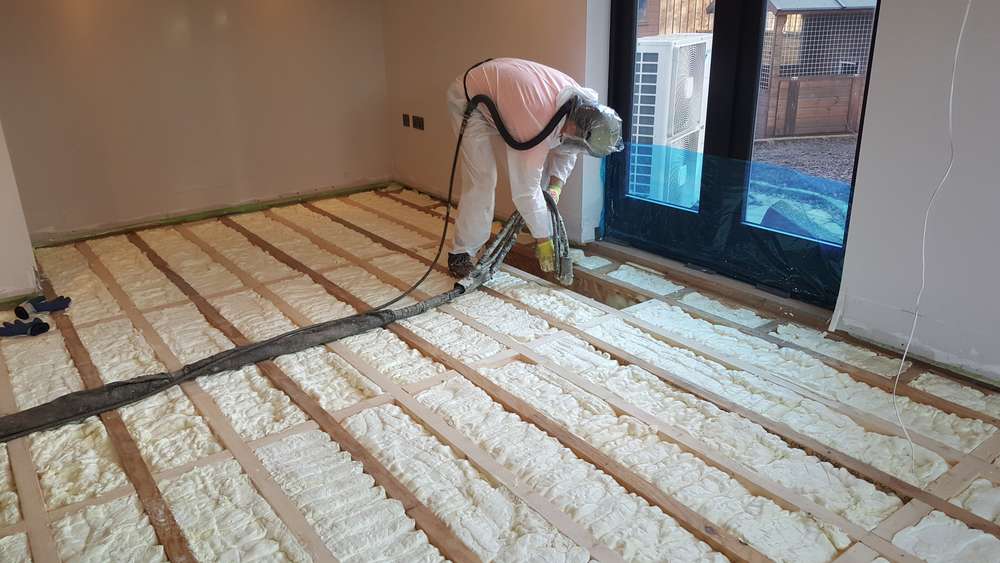Attic Spray Foam Insulation Johnstown
3 Bed Semi Attic Insulation Johnstown

Attic Insulation Johnstown
Spray foam can be useful in many conditions. Spray foam is useful in roofs, windows, attics, underfloor heating systems, interior and exterior walls, as well as roofs.
Spray foam insulation is not only warm and comfortable in winter but also cools your home in summer. The “Cell” structure of the composition allows for moisture to escape, which helps to allow the house to breathe.
Benefits of Spray Foam Insulation for your home
Other applications include commercial and industrial buildings, agricultural farm houses, warehouses, commercial and industrial buildings as well as shipping containers, vessels and the refrigeration industry.
It creates an airtight barrier around your home, keeping out rain and cold winds. It allows the heat from your home to escape, which is what most other insulating products today fail to do.


Cost Price Of Spray Foam Insulation
Spray foam insulation is without doubt the most efficient insulating material today. It has a higher U value than other insulating materials such as rock wool, fiberglass and cellulose.
Spray foam insulation also works well as an sound barrier. It reduces outside noise by up to 50%. It is a great advantage if a company or home is in a densely populated area or close to an airport.
Insulate Your Johnstown Property Properly
It’s commonly used to block sound from traveling between rooms or floors. It’s especially effective on bathroom walls because noises from flushing toilets or showers can make it a nuisance.
It is easy to use and does not cause any disruptions to your daily activities.
In just one day, you can insulate an Irish home.
Encasing and isolating pipes reduces noise in the walls or under-floor.

If you plan on using the loft/attic as storage space, you should lay boards above the joists. The insulation will not be thick enough if it is only between the joists.
It dramatically reduces sound transference when used within walls and attics, roofs, floors and roofs. This is in contrast to fibreglass and rock wool as well as polystyrene and polystyreneboards. The dense composition of the material and the application process result in a completely airtight enclosure. It blocks sound from outside, including traffic, pedestrianised streets, and areas near airports.
It also blocks sounds from a structure’s walls from reaching other floors, including the floors below. Spray foam insulation could reduce the amount of noises generated by structures such as running showers or washing machines.
Spray foam insulation that is both flexible, and filled with millions and millions of air bubbles will absorb the vibrations of the floor. The floor’s wooden members and floor will also be affected. Spray foam insulation reduces transmission of airborne sounds by sealing and filling every crevice.
Spray foam insulation also dampens, if it is not eliminated completely, sounds that could originate from beneath a floor such water flowing through pipes. It completely covers the pipes and prevents them from rattling. It also prevents hot water from flowing through the pipes, which can cause the wooded beams to creak, crackle and expand.
It also keeps heat from escaping to upper floors, which causes lower floors to become colder, which in turn makes them require more heat to keep warm. The upper floors become too hot.
If your loft is easily accessible and does not have condensation problems, insulation should be straightforward.
Uninsulated homes lose 25% of their heat through their roofs. Insulating your flat roof, attic, or loft can help reduce heat loss and decrease your heating costs.
If you have access to your loft joists and it is easy to use, mineral wool insulation rolls can be used. The insulation is first laid between horizontal beams called joists. Once that layer has been laid, another layer of mineral wool insulation is added at right angles.
You can raise the floor to get sufficient insulation. You can either fit timber battens between the joists or buy plastic legs that are specifically designed to fit the joists. To prevent condensation from forming on the boards’ undersides, it is important to ventilate the air gap between insulation and boards.
You should not squash the mineral wool while you place the boards on top. This will decrease its insulation value.
Insulation prevents heat from escaping living spaces. It will make loft space more comfortable and less humid. This could lead to dampening or worsening existing condensation or damp problems. Consider increasing ventilation if you’re installing loft insulation by yourself.
The insulation can be fitted between and over the roofing rafters, which are the flat timbers that support the roof. You can either use rigid insulation boards which are cut precisely to fit your loft, or spray foam insulation between the roof rafters.
Some companies offer to fix a roof that is leaking or damaged by applying foam insulation directly to the roof. This will not solve the problem. This is not something we recommend. Before you add insulation to your roof, make sure it is in good shape.
If you plan to use your loft for heating, you’ll need to make a room in the roof.
You must insulate your loft if you plan to use it as a living area or if you have one.
For your home to remain fresh, dry, healthy and clean, it needs air flow. Installers who are skilled will make sure that you don’t block or seal off any ventilation. Do not cover grilles, airbricks, or vents if you are DIY-insulating.
If you have difficulty accessing your loft, a professional can install the appropriate insulation. The specialist equipment will blow the insulation material into any difficult space. They may use mineral wool fibres, treated cellulose foam or polyurethane.
Flat roof insulation is a great way to save money on heating, as well as loft insulation. The amount of flat roofing on a property will determine how much savings you get.
If the loft is accessible, has no damp problems, and is not on a flat roof you can likely insulate it yourself. Professional installation is recommended for those with damp problems and more complicated insulation systems.
Cold draughts could be caused by the cooler loft air. Install an insulated loft hatch to prevent cold draughts.
Insulating your ground-floor is a great idea to keep your property warm and lower your energy bills.
Insulating your loft is a great way to cut down on heating costs and save energy. It also keeps the home warm in winter. Even if the loft already has insulation in place, it is essential to use it at its best.
Loft floor rolls – These are the classic option. They are laid along the loft’s floor. These are easier than insulated floor boards and require less tools and take less time to lay. These rolls can be used to create top and base layers. You can board them over with stilts to create a raised storage platform.
These items and tips are not included in the article’s list. You should ensure that you’ve read everything before you begin to insulate your loft.
There may be some insulation in your home, but it may not work well. This could be due either to storage boards being placed on top of it, or because the insulation has not been maintained for a long period. In some older properties, the loft floor may only be 25mm deep.
It doesn’t have to be removed from your loft floor insulation. To get the recommended amount, just add one to three layers more. We will discuss how much to recommend in the next section.
The loft floor’s joist spacings will influence the width roll that you choose. This is due to the insulation being rolled between these beams. We recommend that you choose one that is as close as possible to your joist spacing. This will minimize the need to trim excess.
The insulation’s thermal resistance. If you only want to lay loft rolls, there is an alternative method that measures the insulation thickness. For more information, see the section ‘How do I calculate the thickness of loft floor insulation?
Areas We Service


Parkhill, Dublin
01 5255297

